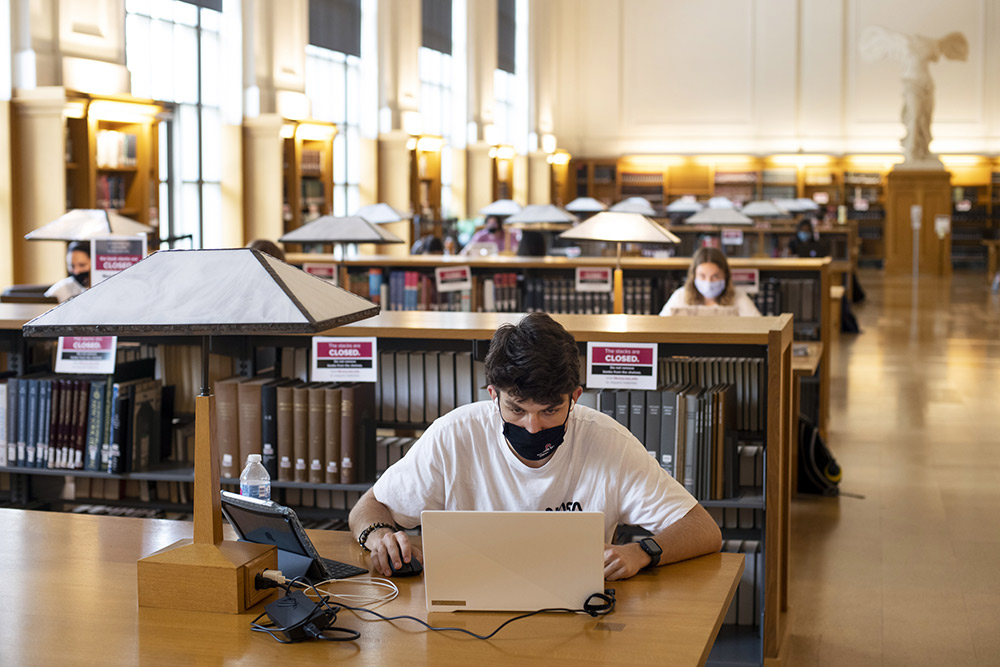
根据美国学生贷款公司萨利美(Sallie Mae)和益普索(Ipsos)的最新报告,去年美国家庭用于大学教育的开支平均为26373美元,较上一年下降12%。
该报告名为《美国家庭如何支付大学学费》(How America Pays for College),对近2000名高校学生的家长进行了调查,覆盖了接受大学教育所需支付的所有费用,包括学费、杂费、食宿费用等等。
数据显示,大多数学院和大学的学费依然保持着上涨势头。根据美国大学理事会(College Board)提供的数据,四年制公立大学本州住校学生的年均费用总计为26820美元,非本州学生为43280美元。四年制私立大学的年均费用则为54880美元。
那么去年的学费支出为何还有所下降呢?萨利美的发言人里克•卡斯特拉诺(Rick Castellano)表示,其部分原因是疫情的影响。一些学校退还了学生的住宿费,另有学生选择在家中远程上课,这些都使得求学成本有所降低。(有些学生甚至根本没报名入学:根据美国全国学生资料库的数据显示,去年高校入学人数出现下降,春季学期下降了3.5%。)
益普索董事珍妮•伯格(Jenny Berg)表示:“我们发现,与去年相比,(入学人数)有所下降。”不过她也指出,去年美国家庭报告的大学费用与两年前一致。因此,现在判断费用下降属于长期趋势还是只是过去两学年剧变的结果依然为时尚早。
美国家庭如何支付大学费用
萨利美和益普索的报告显示,在支付学费时,学生及其家庭近一半的资金来自储蓄和父母的收入,奖学金和助学金平均占比为约25%,学生贷款占比为约11%。

报告显示,在选择贷款的学生中,联邦学生贷款是最常见的资金来源,家庭平均贷款8775美元。此外,超过一半的贷款学生表示,他们在上学期间已开始偿还贷款,从而减少了所欠利息。
但是很多人并未充分利用政府提供的财政补贴。调研显示,仅有68%的受访者表示自己去年提交了联邦学生援助免费申请,创14年来最低水平,两年前该数字为77%。使用奖学金和助学金的学生人数也出现下降。
虽然因新冠疫情影响,去年无论是学生还是其家庭都过得颇为不易,但89%的受访者依然认为上大学“物有所值”,并能为其创造(更好的发展)机会。大约80%的受访者认为,大学学位能为其带来更高的收入。伯格表示:“民众认为上大学能学到有价值的东西,为其所接受的教育花些钱非常划算”,并补充说,过去四年,这种观点并未出现变化。(财富中文网)
译者:梁宇
审校:夏林
根据美国学生贷款公司萨利美(Sallie Mae)和益普索(Ipsos)的最新报告,去年美国家庭用于大学教育的开支平均为26373美元,较上一年下降12%。
该报告名为《美国家庭如何支付大学学费》(How America Pays for College),对近2000名高校学生的家长进行了调查,覆盖了接受大学教育所需支付的所有费用,包括学费、杂费、食宿费用等等。
数据显示,大多数学院和大学的学费依然保持着上涨势头。根据美国大学理事会(College Board)提供的数据,四年制公立大学本州住校学生的年均费用总计为26820美元,非本州学生为43280美元。四年制私立大学的年均费用则为54880美元。
那么去年的学费支出为何还有所下降呢?萨利美的发言人里克•卡斯特拉诺(Rick Castellano)表示,其部分原因是疫情的影响。一些学校退还了学生的住宿费,另有学生选择在家中远程上课,这些都使得求学成本有所降低。(有些学生甚至根本没报名入学:根据美国全国学生资料库的数据显示,去年高校入学人数出现下降,春季学期下降了3.5%。)
益普索董事珍妮•伯格(Jenny Berg)表示:“我们发现,与去年相比,(入学人数)有所下降。”不过她也指出,去年美国家庭报告的大学费用与两年前一致。因此,现在判断费用下降属于长期趋势还是只是过去两学年剧变的结果依然为时尚早。
美国家庭如何支付大学费用
萨利美和益普索的报告显示,在支付学费时,学生及其家庭近一半的资金来自储蓄和父母的收入,奖学金和助学金平均占比为约25%,学生贷款占比为约11%。
报告显示,在选择贷款的学生中,联邦学生贷款是最常见的资金来源,家庭平均贷款8775美元。此外,超过一半的贷款学生表示,他们在上学期间已开始偿还贷款,从而减少了所欠利息。
但是很多人并未充分利用政府提供的财政补贴。调研显示,仅有68%的受访者表示自己去年提交了联邦学生援助免费申请,创14年来最低水平,两年前该数字为77%。使用奖学金和助学金的学生人数也出现下降。
虽然因新冠疫情影响,去年无论是学生还是其家庭都过得颇为不易,但89%的受访者依然认为上大学“物有所值”,并能为其创造(更好的发展)机会。大约80%的受访者认为,大学学位能为其带来更高的收入。伯格表示:“民众认为上大学能学到有价值的东西,为其所接受的教育花些钱非常划算”,并补充说,过去四年,这种观点并未出现变化。(财富中文网)
译者:梁宇
审校:夏林
The average American family spent $26,373 for college last year, down 12% from expenses a year prior, according to the latest report from Sallie Mae and Ipsos.
That includes every single dollar that families put toward college costs, including money spent on tuition, fees, and room and board, as well as transportation costs and technology expenses, according to the How America Pays for College report, which surveys nearly 2,000 parents of college students and undergraduates.
Yet tuition costs have continued to tick up for most colleges and universities. The average total cost of a public four-year university for in-state students staying on campus is $26,820 a year and $43,280 for out-of-state students, according to College Board. A year at a four-year private college costs an average of $54,880 for all expenses.
So why did families report paying less last year? In part, because the pandemic had an impact on college costs, says Rick Castellano, a spokesman for Sallie Mae. Some schools issued refunds for housing costs, while other students opted to remain at home while attending classes remotely—all of which lowered the overall cost. (Some also skipped school entirely: Enrollment at colleges and universities fell in the past year, down 3.5% in the spring semester, according to data from the National Student Clearinghouse.)
“We are seeing a drop compared to last year,” says Jenny Berg, director of Ipsos. But she notes that the college expenses families reported last year are in line with what was reported two years ago. So it’s too early to tell if this is a longer-term trend of declining costs or simply related to the upheaval of the last two academic school years.
How families are paying for college
Students and their families covered nearly half of college costs with savings and parental income, according to the Sallie Mae and Ipsos report. Scholarships and grants covered about 25% of the costs, on average, while student loans made up about 11% of the funding.
Of those students who took out loans, federal student loans were the most common source of funding, and families typically borrowed $8,775 on average, according to the report. Additionally, over half of those who took on loans say they’re already making payments while enrolled in school, thereby minimizing the interest owed.
But many are leaving money on the table in the form of financial aid. About 68% reported filing for the FAFSA last year, the lowest level in the study’s 14-year history and down from the 77% completion rate reported two years ago. The number of students using scholarships and grants is also down.
Yet despite the hardships students and their families faced over the past year with the pandemic, 89% of those surveyed still believe that college is worth it and creates opportunities. About eight out of 10 believe a college degree will translate to higher future career earnings as well. “People feel like they're getting value, that the education they're receiving is worth the price,” Berg says, adding that sentiment has remained steady for the past four years.






